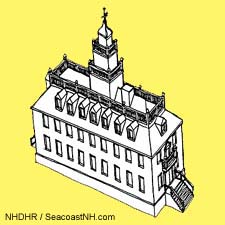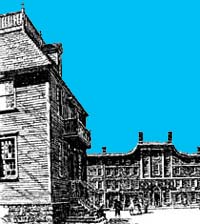|
All About the Old NH Statehouse |
|
Page 1 of 3
 NH's PROVINCIAL CAPITOL
NH's PROVINCIAL CAPITOL
New Hampshire’s first state house has a long and strange history. It was built when NH was a British colony. George Washington spoke from the balcony. It survived all three downtown fires, only to be broken up and moved. It was almost rebuilt at Strawbery Banke. It rests now, in pieces, in a trailer in Concord, NH. And the story still continues. Here is the full chronology by the man who knows the building best.
SEE ALSO: The Day They Took the NH Statehouse
COMPLETE TIMELINE OF THE OLD STATEHOUSE
Portsmouth, NH
A complete timeline prepared by state historian Jim Garvin, NHDHR
18th century (scroll down)
19th century (jump)
20th century (jump)
1741
New Hampshire was separated from Massachusetts by the King in Council..
1742
The Province of New Hampshire emitted 25,000 British pounds in bills of credit to fund the new government and to undertake public works, including construction of a state house. The New Hampshire government continued to meet in rented rooms in Portsmouth taverns.
 1752
1752
The house of representatives appointed Richard Jenness, Henry Sherburne, Jr., and speaker Meshech Weare a committee to join with a delegate from the council, to select a site for a state house, and to prepare a plan for the building.
1753
John Downing of the council presented a plan for a brick state house to measure 30 by 80 feet.
1754
The house of representatives voted that "the Parade, so-called, by the North meeting-House in Portsmouth . . . is the most suitable and proper place to set the said House upon, provided the Town of Portsmouth will consent thereunto."
The house of representatives voted to appropriate 2,000 pounds to build the state house, but voted that the materials be changed from brick to wood and that a cupola, shown on the plan, be omitted.
1757
After several unsuccessful attempts to get Governor Benning Wentworth to assent to the house vote, the house increased the appropriation to 2,500 pounds new tenor and the governor concurred.
Henry Sherburne, Jr., and Clement March.of the house joined Mark Hunking Wentworth (Governor Wentworth's brother) and Daniel Warner (Henry Sherburne Jr.'s father-in-law) of the council to form a building committee charged with contracting for "the building of said house [with] such person or persons as will build the same in the best manner."
 1758
1758
The committee advertised for bids to frame, raise, and finish the exterior of the building. A few weeks later, this invitation was followed by a second advertisement for completing the glazing, painting, and chimney, together with interior floors, partitions and plastering.
1759
The building was illuminated with fifty pounds of candles to celebrate the capture of Quebec.
1760
The first stage of construction was completed. Total cost was 3,773.3.0-1/4 pounds new tenor, leaving a deficit in the building fund of 1,273.3.0-1/4 pounds.
1762
The building was furnished with chairs, tables, fireplace equipment, and writing supplies.
1764
The house of representatives voted to complete the structure. The second phase of construction included the addition of stone steps at the two end doors, a cupola, a balcony at the eastern end on the second story, and a roof balustrade.
1765
Protests against the Stamp Act were held at the state house.
1767
NH's Gov. John Wentworth was inaugurated in the state house. Wentworth was an American by birth and ancestry, though a British subject like everyone else in New Hampshire.
1769
The second phase of construction and finishing was completed.
1774
A protest against the importation of British tea was held at the state house. (After the attack on Frot William and Mary in 1774, Gov. Wentworth was driven from Portsmouth in 1775.)
1776
The Declaration of Independence was read from the state house balcony.
1783
Peace with Great Britain was declared at the state house.
1789
The state house was illuminated to celebrate New Hampshire's ratification of the United States Constitution. New Hampshire's vote (the ninth of thirteen) established the Constitution as the plan of government for the nation.
1789
President George Washington was received by the citizens of Portsmouth, making a speech from the balcony.
CONTINUE to read the STATEHOUSE HISTORY
Please visit these SeacoastNH.com ad partners.



 Smuttynose Murders
Smuttynose Murders



 NH's PROVINCIAL CAPITOL
NH's PROVINCIAL CAPITOL 1752
1752 1758
1758














